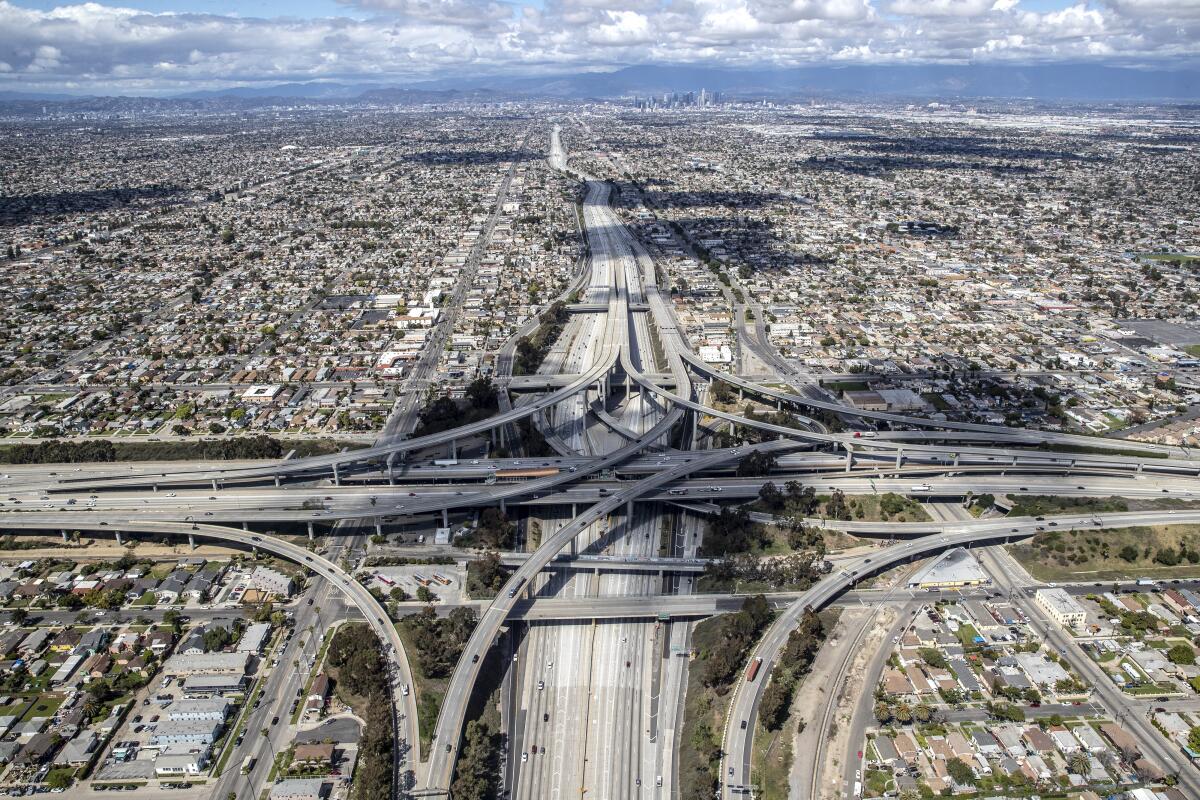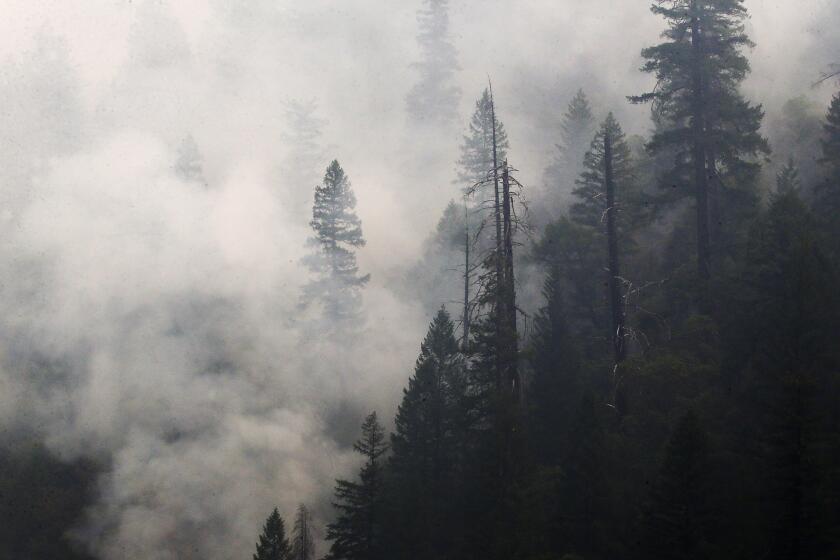California set a record for greenhouse gas reductions in 2020, but it means nothing

- Share via
First, the good news: The amount of planet-warming gases Californians released into the atmosphere in 2020 was 9% less than the previous year — a record decline mostly because of motorists driving less amid the COVID-19 lockdown.
Now, the bad news: The quantity of carbon dioxide spewed by record-setting wildfires that same year effectively erased almost two decades of emission reductions on the part of the world’s fifth — and soon to be fourth — largest economy.
Those two findings — both released in a little more than a week’s time this month — have painted a grim and confusing portrait of California’s efforts to curb global warming. They also come as a U.N. report finds that global greenhouse gas reduction efforts are “highly inadequate.”
Officials at the ports of Los Angeles and Long Beach recorded an unprecedented surge in harmful emissions during 2021. They blame COVID-19.
Word that Californians had effectively reduced carbon dioxide emissions by 35 million metric tons in 2020 — the equivalent of 94 coal plants operating for a year — was announced last week as a part of the California Air Resources Board’s annual greenhouse gas emission inventory.
The inventory, however, did not account for the roughly 127 million metric tons of carbon dioxide equivalent that were released by the state’s 2020 wildfires. That piece of the equation was announced earlier this month by UCLA researchers. They found that wildfires were second only to transportation as the state’s primary source of planet-warming gases in 2020, ahead of industry and electrical power generation.
Asked why their inventory did not include that information as well, CARB said it was designed to estimate heat-trapping gases produced from all sectors of the state economy, including industrial transportation, electricity, agriculture, commercial and residential sectors.
“We do track wildfire emissions on an annual basis, but they are not part of the GHG Inventory ... which tracks emissions from fossil fuels and high-global warming potential gases such as methane and HFC refrigerants,” said CARB spokesperson David Clegern.
They said the agency did include wildfires when it calculated its draft 2022 Scoping Plan, which urges state and federal authorities to drastically increase the thinning and treatment of forests that have become dangerously overgrown with flammable vegetation.
“We are working with other state agencies on ways to stabilize forests and return them to sustainability as carbon sinks. In the meantime, it is essential that we work even harder to reduce fossil fuel emissions as it is clear that they are driving the overall problem and we have the means to make those reductions now,” Clegern said.
As wildfires become more extreme, some worry California will near a tipping point in which its forests emit more carbon dioxide than they absorb.
Since it started in 2000, the annual estimate of statewide greenhouse gas emissions has been viewed as an important metric in tracking the state’s progress toward its climate goals. However, state officials said 2020 was an anomalous year, and that they expected to see an increase when they calculated the 2021 inventory.
In 2020, the transportation sector accounted for the largest decline in emissions, with 27 million metric tons fewer carbon emissions, or about 16% less, compared with 2019. This was largely from fewer cars being on the road during the shelter-in-place orders.
In April 2020, California motorists drove 44% fewer miles than in April 2019. Miles driven have since rebounded to pre-pandemic levels, state officials said. Heavy-duty truck mileage also dropped 13% in April 2020 compared with the same month the year prior, but later surpassed 2019 levels as consumer demand grew during the shutdown.
“This year will be looked at as an outlier and cannot be used as a reliable data point to predict trends for the years to come,” said Steven Cliff, executive officer at CARB. “It also made clear however, that as we build back we must continue with the actions that we know will reduce greenhouse gases and clean the air and our hardest hit communities, including deployment of renewable energy and zero emission cars and trucks on our roadways and highways.”
Gas stoves may emit unhealthful pollutants even when not in use, a study finds. High levels of cancer-causing benezene were found in Southern California.
Danny Cullenward, policy director of CarbonPlan, a California nonprofit that analyzes climate solutions, said he agreed that there was not much to be gleaned from the 2020 numbers.
“The whole issue is what happens after the pandemic year, and that’s not something this inventory speaks to,” he said. “If you’re wondering, are we on track for our goals? How are things looking? It was an anomalous year. There’s nothing surprising in the data released. It was not a very representative year. What matters is what happens as we came out of it.”
The two-year lag in publishing greenhouse gas emissions in California, however, presents an obstacle to an expeditious response, he said.
“It’s kind of weird that here we are in October 2022 and we’re talking about what happened in 2020,” Cullenward said.
“The delay contributes to a lack of oversight and reduces the potential for policymakers to update their thinking,” he said.
More to Read
Toward a more sustainable California
Get Boiling Point, our newsletter exploring climate change, energy and the environment, and become part of the conversation — and the solution.
You may occasionally receive promotional content from the Los Angeles Times.










